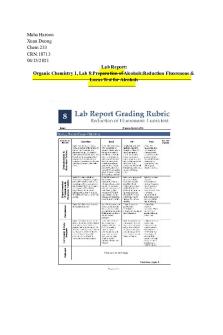Orgo lab 2 - Stereochemistry of Bromine Addition PDF

| Title | Orgo lab 2 - Stereochemistry of Bromine Addition |
|---|---|
| Course | Elem Organic Chem Lab |
| Institution | University of Alabama |
| Pages | 7 |
| File Size | 439 KB |
| File Type | |
| Total Downloads | 36 |
| Total Views | 125 |
Summary
Stereochemistry of Bromine Addition...
Description
Dequiala Kelly CH 237-025 Yinghui Liu 17 February, 2021
Introduction Chemical engineers at The Bond Triplex Company had trouble determining the stereochemical structures of the intermediates of dibromide. here are three possible products for the addition of bromine to trans-cinnamic acid: erythro-dibromide, threo-dibromide or a mixture of both. Each product consists of a different mechanism. Anti-addition mechanism yields erythron-2,3-dibromo-3-phenylpropanic acid, syn addition yields threo-2,3-dibromo-3phenylpropanoic acid, and non-stereoselective mechanism which yields a mixture of both erythro and theo products. In order to determine the mechanism, a solution of bromine in acetic acid will be added to a solution of trans-cinnamic acid to be separated using vacuum filtration. Once filtered, the product will be purified using recrystallization and the melting point will be identified. The melting point of the product will be used to determine which of the three possible products is produced.
Results 1. Theoretical yield: Amount of trans-cinnamic acid used: 1.48g Amount of 2,3-dibromo-3-phenylpropanoic acid made: 2.38g
Molecular weight of trans-cinnamic acid:148.2g/mol Molecular weight of 2,3-dibromo-3-phenylpropanoic acid: 308g/mol Therefore, 1.48g x
1 mol 148.2
1 mol product
x 1 mol reactant
308 g
x 1 mol product = 3.08g
2. Percent Yield: 2.38(actual) 3.08 (theorectial)
x 100% = 77.3%
3. Melting point range: 198-200°C
Discussion The main purpose of this experiment was to determine the product produced from the addition of bromine to trans-cinnamic acid and measure the melting points. The results indicate that the melting point range of the product was between 198 degrees Celsius and 200 degrees Celsius. Although the precent yield of the experiment was 77.3%, meaning 22.7% of the product was lost. This could have been a result of the product being left in the flask or errors during the recrystallization process. Despite the errors, according to the book, erythron-2,3-dibromo-3phenylpropanoic acid has a melting point within the experimental range. As a result of the melting point, the product is, erythron-2,3-dibromo-3-phenylpropanoic acid This means that the mechanism that occurred was a result of anti-addition of bromine.
Conclusion
The results of this experiment, concluded that the addition of bromine of trans-cinnamic acid underwent an anti-addition mechanism. Based upon the melting point, the mechanism produced erythron-2,3-dibromo-3-phenylpropanoic acid.
Questions
1. Bromonium ion mechanism
2. The products that would be formed is (2S,3S)-diromo-3phenyl propanoic acid and (2R, 3R)-dibromo--3phenyl propanoic acid. The relationship between the two products is that they are racemic mixtures.
3. The purpose of the cyclohexane was to have it react with the excess bromine left over in the solution....
Similar Free PDFs

Orgo 2 Lab Experiment 2
- 16 Pages

Orgo 2 prelab 2 - lab
- 4 Pages

Orgo Lab 2 - organic chem lab 2
- 5 Pages

Orgo I Lab 4 - orgo
- 8 Pages

Orgo 2 lab 4 - Lab report
- 14 Pages

Orgo Post-lab 8 - Orgo- Lab report
- 14 Pages

Orgo post lab questions 2
- 2 Pages

ORGO 2 POST LAB 8 - POST LAB
- 14 Pages

Orgo 2 Lab 3 - Lab report 3
- 5 Pages

Orgo 2 Lab 10 - Lab Report 10
- 4 Pages

Orgo 2 lab 5 - lab report
- 6 Pages
Popular Institutions
- Tinajero National High School - Annex
- Politeknik Caltex Riau
- Yokohama City University
- SGT University
- University of Al-Qadisiyah
- Divine Word College of Vigan
- Techniek College Rotterdam
- Universidade de Santiago
- Universiti Teknologi MARA Cawangan Johor Kampus Pasir Gudang
- Poltekkes Kemenkes Yogyakarta
- Baguio City National High School
- Colegio san marcos
- preparatoria uno
- Centro de Bachillerato Tecnológico Industrial y de Servicios No. 107
- Dalian Maritime University
- Quang Trung Secondary School
- Colegio Tecnológico en Informática
- Corporación Regional de Educación Superior
- Grupo CEDVA
- Dar Al Uloom University
- Centro de Estudios Preuniversitarios de la Universidad Nacional de Ingeniería
- 上智大学
- Aakash International School, Nuna Majara
- San Felipe Neri Catholic School
- Kang Chiao International School - New Taipei City
- Misamis Occidental National High School
- Institución Educativa Escuela Normal Juan Ladrilleros
- Kolehiyo ng Pantukan
- Batanes State College
- Instituto Continental
- Sekolah Menengah Kejuruan Kesehatan Kaltara (Tarakan)
- Colegio de La Inmaculada Concepcion - Cebu




